How Do You Transport a Wheelchair in a Car?

The simplest way, assuming the wheelchair is small enough,and your car’s trunk space is large enough, is to buy a wheelchair that comes with a wheelchair transport bag, collapse the wheelchair, place it in the bag, and stow it securely in the trunk. However, that’s now always possible, so we’ll provide a more detailed answer below.
In More Detail – How to Transport a Wheelchair
Before we get into the particulars of wheelchair transport, there are a few other things to discuss to lay the groundwork. All of the details below will save you time and trouble, and ensure that your transport is smooth, seamless and headache free.
Know Your Chair
If there’s one piece of information that will make your life easier when it comes to transporting a wheelchair, regardless of type, it is this: Know. Your. Chair. The key things you need to know are as follows:
If you don’t know the precise answers to these questions, you’re going to struggle with transport. There are few things worse than standing out in the rain trying to figure out how to collapse the wheelchair so you can store it in your car—getting soaked to the bone and more frustrated by the minute—only to discover that the chair won’t “fit” where you wanted to put it. Don’t let that happen to you – do your homework first!
Know the Person Using the Chair
Also bear in mind that if you’re transporting a wheelchair, odds are that you’re transporting the person in it, so you’ll want to be mindful of several things:
Of course, if the person using the wheelchair can walk unassisted for short periods, then he or she may be able to get from wheelchair to vehicle under their own power. So much the better, but again, it comes down to knowing the person using the chair!
Know Your Car
Knowing the particulars of the wheelchair you’re transporting is only half the battle. You’ve also got to have a firm understanding of the amount of storage space your vehicle has. It doesn’t do you any good to know that your wheelchair breaks down into a tidy 25-pound package measuring 8” x 25” x 16” if you don’t know whether or not that will fit into your trunk without attempting to wrestle it into place.
At a minimum, you should know the following:
If you know going in that the chair you’ve got just won’t fit in the trunk space you have (or behind the seats), then there are other transport options to consider, and we’ll cover those in the next section.
Options, Options, Options
So, now that we’ve laid the groundwork let’s talk about precisely how to transport a wheelchair in detail. There are a lot more options here than you might think, especially if you’ve only recently found yourself in need of a wheelchair or have recently begun assisting someone who’s using one. We’ll talk about each option in turn.
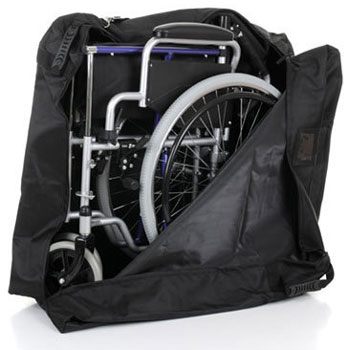
The Old-Fashioned Way
As we mentioned at the start, far and away the most straightforward answer to the question “how to transport a wheelchair” is to buy one that comes with its own carrying case. Not all wheelchairs do, but the ones that do will say so in their product descriptions.
These tend to be very lightweight, so it’s easy to get them into and out of the bag, and into and out of your trunk too. Just break it down (collapse it) so it’s got a smaller footprint, slide the bag over it, then stash the bag in the trunk of your car and you’re done.
Of course, that only works if you read this article before you went out and purchased your wheelchair. If you’ve already purchased one, and yours doesn’t come with a handy transport bag, then we’ll have to get a little more creative. We’ve got that covered just below!
A Transport Rack
So, what happens if you’ve purchased a wheelchair that’s just too big to fit in the trunk of your car or behind the seats? Before you get frustrated and send the wheelchair back, consider the possibility of getting a wheelchair storage rack for your vehicle.
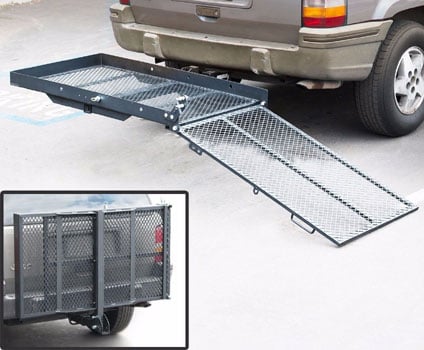
These come in two basic flavors: Bumper mounted and top mounted (which affix to the luggage rack on top of your vehicle, if you’ve got one).
Both work well, but in practice, the bumper-mounted racks are easier to use, if for no other reason than the top-mounted racks see you lifting the wheelchair over your head to slide it into position. That’s fairly easy if you’re transporting an ultralight wheelchair, but some of them can be quite heavy, and unless you relish the thought of combining a good cardio workout with wheelchair transport, the bumper-mounted variety is the way to go.
Each model is slightly different in its design, but the idea is the same. You break the wheelchair down and mount it on the rack. In some cases, the chair will “hook” onto the rack, and in others, it will be held in place by a bar you can tighten down with wing nuts. At the end of the day though, the result is the same. You get an easy, convenient way to transport your wheelchair, even if you lack the trunk space to get the job done.
A Ramp Assist
Ramps are a great, easy way to get a wheelchair into a vehicle, but of course, that mostly depends on the vehicle. Ramps are relatively useless where sedans are concerned but can be invaluable if you have a truck, van, or even some SUV’s.

Here, you’ll leave the wheelchair in its “ready for sitting” state, roll it up the ramp, and once you’ve got it in the vehicle, either lock the brakes for transport or collapse and secure it, whichever makes the most sense. In a van, you can likely just leave it as it is and lock the brakes, but in the back of a pickup truck, you’ll probably want to collapse and secure it.
If you’re dealing with an electric wheelchair or mobility scooter, the user can just ride the chair up the ramp. Although this works best when used in conjunction with a van – after all, once the rider is in the back of the pickup truck, then you’ll be left with the challenge of how to get him or her back down!
Remember that the ramp will need to be on the long side because you want to keep the slope fairly gentle. If it’s too steep, it’s not going to help you a bit.
A Pull-Behind Trailer
This is a good option for those who have electric wheelchairs or mobility scooters. The huge advantage is that there’s no disassembly required.
You’ll need a short ramp to drive the scooter onto the trailer, lock the brakes and secure it with tie-downs for the trip, then help the user get from the trailer to the vehicle, and you’re all set.
Of course, this implies that you’ve got a vehicle with a trailer hitch that can handle the weight of the trailer itself plus the wheelchair or scooter you plan to put on it. You’ll also need to attend to the wiring issues so that the trailers’ tail lights and blinkers function well.
If you’ve already got a trailer and use it for other purposes, then all this is likely done. If not, then your best bet is to work with someone who’s got a trailer, enlisting their aid to be sure the wiring is done correctly.
Note that this is a relatively poor solution for transport chairs and manual wheelchairs. It’s just overkill, and there are better, less expensive options available.
An Electric Lift
This is a serious piece of equipment and may wind up costing you more than your chair unless you have a high-end electric wheelchair or mobility scooter.

These are mounted at the rear of your vehicle like the rear mounted racks we talked about above, but they have a key difference: There’s a platform which can be raised and lowered at the touch of a button.
In this case, you lower the platform to ground level, drive (or push) the wheelchair or scooter onto it, secure the chair on it with straps, then raise the platform back off the ground for transport.
As with the trailer solution, this is overkill for all transport chairs and all but the biggest, most deluxe and heaviest manual wheelchairs, but is an excellent solution for electric wheelchairs and scooters, because you don’t have to bother with disassembling it.
To make the best use of a lift like this though, you’ll need a truck, van, or full-sized SUV. It just won’t work on a sedan or a smaller SUV.
What’s the Best Vehicle for Wheelchair Transport?
This is a great question, and once again, it comes down to knowing your wheelchair. The “best” will vary depending on what type of chair you’re talking about. For instance:
We’ll summarize all that in the table below:
| Best Vehicle for Wheelchair Transport | 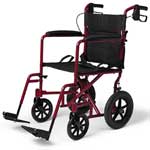 Lightweight Transport Chair Lightweight Transport Chair | 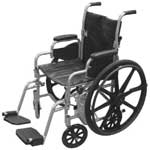 Standard Wheelchair Standard Wheelchair | 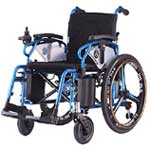 Electric Wheelchair or Mobility Scooter Electric Wheelchair or Mobility Scooter |
|---|---|---|---|
|
Full-Sized Sedan or Hatchback | Yes (no real “best” choice but this is probably the most convenient). In most cases, you won’t need an externally mounted rack or any special equipment. | Yes. Smaller standard wheelchairs will fit in the trunk. Mid-sized or larger, and you’ll likely need a bumper-mounted or rack-mounted carrier. | Usually impossible without using a bumper mounted rack. Most of these are just too big to fit into available trunk space. |
|
Pickup Truck | Yes (the only concern here will be securing the chair so it doesn’t slide around the bed during transport) | Yes, but weight is a factor here. The heavier the chair, the more difficult it’s going to be to lift it into the bed, so a lift may be required to make that easier. You’re also going to need a means of securing it so it doesn’t slide around the bed during transport. | Possible, but you’ll definitely want a lift to get it into the truck bed, and again, you’ll need some means of securing it so it doesn’t slide all over the place during transport. |
|
SUV | Yes | Yes (Ideal choice). Getting most wheelchairs into and out of most SUV’s should be a fairlysimple proposition. | Smaller SUV’s will struggle with bigger electric wheelchairs and scooters, though it should be possible to get most into a full-sized SUV, though again, you’ll likely need a lift to assist. A rear-mounted rack is another option. |
|
Van | Yes (overkill, really, but easily doable) | Yes (again, this is likely overkill but easily doable) | Yes (best option). A van with ramp access is the best, easiest and most convenient option here. |
How to Transport a Wheelchair Conclusion
As you can see then, the answer to the question “how to transport a wheelchair” is a bit more complex than first meets the eye. It really comes down to a question of what kind of wheelchair you’re transporting; whether you’re comfortable with the idea of collapsing the chair, or breaking it into its component parts and reassembling it when you reach your destination, and whether or not you have assistance handy when it comes to loading and unloading it.
If you want one simple, quick, surefire answer, then buy a van. It may be overkill in most cases, but it’s probably the easiest option. If that’s just not in the budget for you though, or not something you want to do (let’s face it, not everybody likes the idea of driving around in a van), there are other viable options available.
Ultimately then, the real question is what option works best for you? The problem with a lot of the alternative solutions mentioned here is that they require a bit of (and in some cases, a hefty) upfront investment.
If your wheelchair transport needs are short-term, you’ll probably want to keep things as simple and inexpensive as possible. But if you know you’ve got a long-term need for it, then your thinking should probably reflect that, in which case these more expensive options begin to look a lot more attractive.